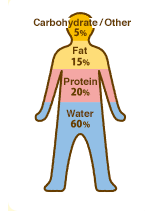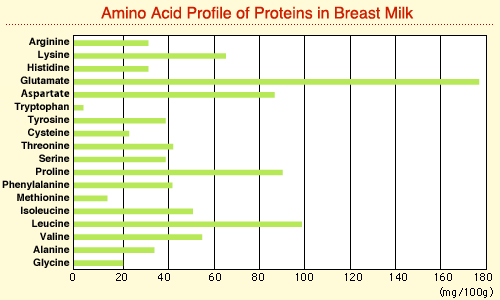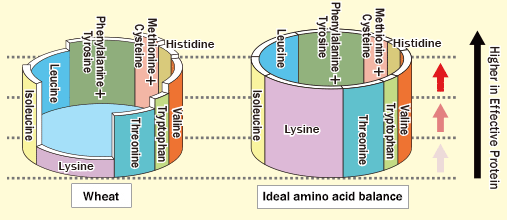- Home
- Company
- Amino Acid Encyclopedia
- Learn All about Amino Acids!
- What Are Amino Acids?
What Are Amino Acids?
Amino acids are essential for life. Amino acids support the functions of the body.
Amino Acids—Discovered from Asparagus
The first amino acid was discovered in 1806 in France and was isolated from asparagus. It was named asparagine. Later on, cysteine was discovered from urinary stones, glycine from gelatin, and leucine from muscle and wool. By 1935, all the amino acids that make up proteins had been discovered.
Many of us have heard of glutamate. German chemist Karl Heinrich Ritthausen isolated it from the wheat protein gluten in 1866 and gave it its name. In 1908, Japanese researcher Kikunae Ikeda discovered that glutamate was what gave kombu dashi (a stock made from kelp) its umami taste. He had therefore discovered that amino acids hold the secret to delicious taste. This inspired extensive research in Japan and other countries, in order to uncover the different functions of amino acids.
Amino Acids—the Essential for Human Life
There are a number of theories about the origins of human life. Some suggest that life did not originate on Earth while others suggest that it originated in the primordial atmosphere or sea. However, scientists agree that amino acids are the essential for human life.
Amino acids have been found in meteorites that have travelled long distances through space. A meteorite found near Murchison, Australia was discovered to contain traces of glycine, alanine, glutamate and beta-alanine. These are all amino acids. This suggests that some form of life has existed on other planets. Alanine and other amino acids have also been detected in trilobite fossils that are 500 million years old. Scientists continue to study meteorites and fossils, hoping to unlock the mystery of how life originated from amino acids.
Amino acids are the essential for human life.

Amino Acids Make up 20% of the Human Body
Our bodies are made of 60% water and 20% proteins. That means a person who weighs 50 kilograms (110 lb) would have 10 kilograms (22 lb) of protein. These proteins form important tissue in the body including muscle, the gastrointestinal tract, internal organs, blood hemoglobin, and collagen in hair and skin. These proteins are built from amino acids, thus it can be said that our body is made of amino acids.
Twenty Amino Acids Make up the Proteins in the Body
Roughly 500 amino acids have been identified in nature, but just 20 amino acids make up the proteins found in the human body (see diagram).
When we eat foods such as meat, fish, and grains, our bodies first digest the proteins in these foods into those 20 amino acids. These amino acids are then reassembled to make other proteins for our bodies.
There are 11 amino acids that the body can make from other amino acids. However, it cannot make the remaining nine amino acids. We can only get them from eating food. Amino acids that cannot be made by our bodies are called "essential amino acids." Amino acids that can be made by our bodies are called "non-essential amino acids." These names are a bit misleading. In fact, scientists believe that as humans evolved, we retained the ability to make certain amino acids because they are essential to our lives.
In addition to amino acids that our bodies use to make proteins in the body there are also free amino acids that are stored in cells and blood. In many cases free amino acids, which include non-essential amino acids, are essential to maintaining our bodies.
Twenty Amino Acids that Make up the Human Body
Valine , Leucine , Isoleucine , Alanine , Arginine , Glutamine , Lysine , Aspartate , Glutamate , Proline , Cysteine , Threonine , Methionine , Histidine,Phenylalanine , Tyrosine , Tryptophan , Aspargine , Glycine , Serine
Amino Acid Balance
The required amounts of nine essential amino acids for our body are defined by the international organizations (FAO / WHO / UNU).
These are called the amino acids scoring patterns.
It is called a limiting amino acid that is less than the amino acids scoring pattern. The nutritional value of the protein can be improved by supplementing the limiting amino acid.
Amino acid score is a numerical value showing how much the smallest limiting amino acid satisfies the scoring pattern. It can be said that a protein with an amino acid score close to 100 is good quality protein.
In general, animal proteins such as egg are good proteins with high amino acids scores. On the other hand, the scores of vegetable proteins such as wheat and corn are known to be low.
Cereal Protein Tends to Lack Lysine
Egg protein has an amino acid score of 100! That's why egg protein can be said to be a good protein with the most balanced amino acids. Wheat protein has an amino acid score of 50, while milled rice has a score of 82.
In particular, wheat protein and milled rice have very little of the essential amino acid lysine.
![]()

Breast Milk—Full of Amino Acids
Breast milk is rich in amino acids with a well-balanced profile of essential amino acids (see diagram) .That is why a newborn child can grow healthily consuming only breast milk.
![]()

Yamaguchi et al., Food Reviews International, 14, 178, 1998
![]()

Traditional Diets Show our Ancestors' Wisdom
Rice is a staple of the Japanese diet and contains 7% protein. Wheat is a staple of North American and European diets and contains 11% protein. However, rice and wheat have different amino acid profiles.
Rice is slightly deficient in lysine, while legumes are rich in lysine. This means that eating both soy products, such as miso and tofu, and rice is ideal for getting the essential amino acids.
Wheat is low in the essential amino acids lysine, methionine, and threonine, which can be supplemented by consuming meat and dairy products that are rich in these amino acids.
Around the world we find that traditional diets reflect the health insights and wisdom of our ancestors.
![]()


